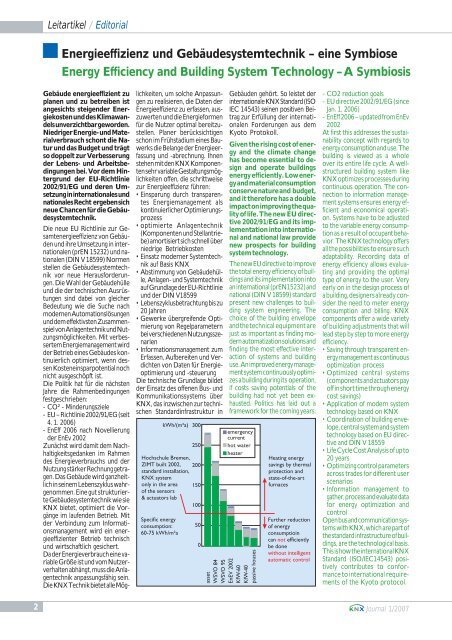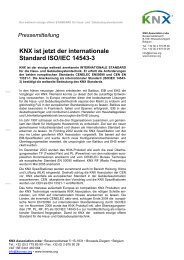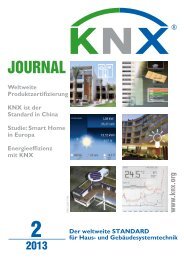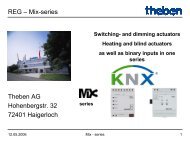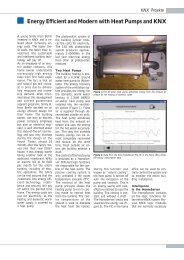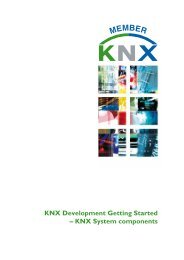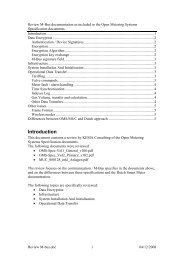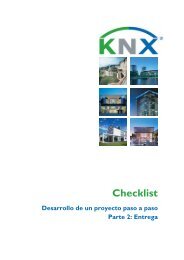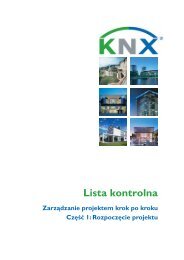JOURNAL - KNX
JOURNAL - KNX
JOURNAL - KNX
Erfolgreiche ePaper selbst erstellen
Machen Sie aus Ihren PDF Publikationen ein blätterbares Flipbook mit unserer einzigartigen Google optimierten e-Paper Software.
Leitartikel / Editorial<br />
Energieeffizienz und Gebäudesystemtechnik – eine Symbiose<br />
Energy Efficiency and Building System Technology – A Symbiosis<br />
Gebäude energieeffizient zu<br />
planen und zu betreiben ist<br />
angesichts steigender Energiekosten<br />
und des Klimawandels<br />
unverzichtbar geworden.<br />
Niedriger Energie- und Materialverbrauch<br />
schont die Natur<br />
und das Budget und trägt<br />
so doppelt zur Verbesserung<br />
der Lebens- und Arbeitsbedingungen<br />
bei. Vor dem Hintergrund<br />
der EU-Richtlinie<br />
2002/91/EG und deren Umsetzung<br />
in internationales und<br />
nationales Recht ergeben sich<br />
neue Chancen für die Gebäudesystemtechnik.<br />
Die neue EU Richtlinie zur Gesamtenergieeffizienz<br />
von Gebäuden<br />
und ihre Umsetzung in internationalen<br />
(prEN 15232) und nationalen<br />
(DIN V 18599) Normen<br />
stellen die Gebäudesystemtechnik<br />
vor neue Herausforderungen.<br />
Die Wahl der Gebäudehülle<br />
und die der technischen Ausrüstungen<br />
sind dabei von gleicher<br />
Bedeutung wie die Suche nach<br />
modernen Automationslösungen<br />
und dem effektivsten Zusammenspiel<br />
von Anlagentechnik und Nutzungsmöglichkeiten.<br />
Mit verbessertem<br />
Energiemanagement wird<br />
der Betrieb eines Gebäudes kontinuierlich<br />
optimiert, wenn dessen<br />
Kosteneinsparpotential noch<br />
nicht ausgeschöpft ist.<br />
Die Politik hat für die nächsten<br />
Jahre die Rahmenbedingungen<br />
festgeschrieben:<br />
- CO² - Minderungsziele<br />
- EU – Richtlinie 2002/91/EG (seit<br />
4. 1. 2006)<br />
- EnEff 2006 nach Novellierung<br />
der EnEv 2002<br />
Zunächst wird damit dem Nachhaltigkeitsgedanken<br />
im Rahmen<br />
des Energieverbrauchs und der<br />
Nutzung stärker Rechnung getragen.<br />
Das Gebäude wird ganzheitlich<br />
in seinem Lebenszyklus wahrgenommen.<br />
Eine gut strukturierte<br />
Gebäudesystemtechnik wie sie<br />
<strong>KNX</strong> bietet, optimiert die Vorgänge<br />
im laufenden Betrieb. Mit<br />
der Verbindung zum Informationsmanagement<br />
wird ein energieeffizienter<br />
Betrieb technisch<br />
und wirtschaftlich gesichert.<br />
Da der Energieverbrauch eine variable<br />
Größe ist und vom Nutzerverhalten<br />
abhängt, muss die Anlagentechnik<br />
anpassungsfähig sein.<br />
Die <strong>KNX</strong> Technik bietet alle Mög-<br />
Imprint<br />
lichkeiten, um solche Anpassungen<br />
zu realisieren, die Daten der<br />
Energieeffizienz zu erfassen, auszuwerten<br />
und die Energieformen<br />
für die Nutzer optimal bereitzustellen.<br />
Planer berücksichtigen<br />
schon im Frühstadium eines Bauwerks<br />
die Belange der Energieerfassung<br />
und -abrechnung. Ihnen<br />
stehen mit den <strong>KNX</strong> Komponenten<br />
sehr variable Gestaltungsmöglichkeiten<br />
offen, die schrittweise<br />
zur Energieeffizienz führen:<br />
• Einsparung durch transparentes<br />
Energiemanagement als<br />
kontinuierlicher Optimierungsprozess<br />
• optimierte Anlagentechnik<br />
(Komponenten und Stellantriebe)<br />
amortisiert sich schnell über<br />
niedrige Betriebkosten<br />
• Einsatz moderner Systemtechnik<br />
auf Basis <strong>KNX</strong><br />
• Abstimmung von Gebäudehülle,<br />
Anlagen- und Systemtechnik<br />
auf Grundlage der EU-Richtlinie<br />
und der DIN V18599<br />
• Lebenszyklusbetrachtung bis zu<br />
20 Jahren<br />
• Gewerke übergreifende Optimierung<br />
von Regelparametern<br />
bei verschiedenen Nutzungsszenarien<br />
• Informationsmanagement zum<br />
Erfassen, Aufbereiten und Verdichten<br />
von Daten für Energieoptimierung<br />
und -steuerung<br />
Die technische Grundlage bildet<br />
der Einsatz des offenen Bus- und<br />
Kommunikationssystems über<br />
<strong>KNX</strong>, das inzwischen zur technischen<br />
Standardinfrastruktur in<br />
Gebäuden gehört. So leistet der<br />
internationale <strong>KNX</strong> Standard (ISO<br />
IEC 14543) seinen positiven Beitrag<br />
zur Erfüllung der internationalen<br />
Forderungen aus dem<br />
Kyoto Protokoll.<br />
Given the rising cost of energy<br />
and the climate change<br />
has become essential to design<br />
and operate buildings<br />
energy efficiently. Low energy<br />
and material consumption<br />
conserve nature and budget,<br />
and it therefore has a double<br />
impact on improving the quality<br />
of life. The new EU directive<br />
2002/91/EG and its implementation<br />
into international<br />
and national law provide<br />
new prospects for building<br />
system technology.<br />
The new EU directive to improve<br />
the total energy efficiency of buildings<br />
and its implementation into<br />
an international (prEN15232) and<br />
national (DIN V 18599) standard<br />
present new challenges to building<br />
system engineering. The<br />
choice of the building envelope<br />
and the technical equipment are<br />
just as important as finding modern<br />
automatization solutions and<br />
finding the most effective interaction<br />
of systems and building<br />
use. An improved energy management<br />
system continuously optimizes<br />
a building during its operation,<br />
if costs saving potentials of the<br />
building had not yet been exhausted.<br />
Politics has laid out a<br />
framework for the coming years:<br />
- CO2 reduction goals<br />
- EU directive 2002/91/EG (since<br />
Jan. 1, 2006)<br />
- EnEff 2006 – updated from EnEv<br />
2002<br />
At first this addresses the sustainability<br />
concept with regards to<br />
energy consumption and use. The<br />
building is viewed as a whole<br />
over its entire life cycle. A wellstructured<br />
building system like<br />
<strong>KNX</strong> optimizes processes during<br />
continuous operation. The connection<br />
to information management<br />
systems ensures energy efficient<br />
and economical operation.<br />
Systems have to be adjusted<br />
to the variable energy consumption<br />
as a result of occupant behavior.<br />
The <strong>KNX</strong> technology offers<br />
all the possibilities to ensure such<br />
adaptability. Recording data of<br />
energy efficiency allows evaluating<br />
and providing the optimal<br />
type of energy to the user. Very<br />
early on in the design process of<br />
a building, designers already consider<br />
the need to meter energy<br />
consumption and billing. <strong>KNX</strong><br />
components offer a wide variety<br />
of building adjustments that will<br />
lead step by step to more energy<br />
efficiency.<br />
• Saving through transparent energy<br />
management as continuous<br />
optimization process<br />
• Optimized central systems<br />
(components and actuators pay<br />
off in short time through energy<br />
cost savings)<br />
• Application of modern system<br />
technology based on <strong>KNX</strong><br />
• Coordination of building envelope,<br />
central system and system<br />
technology based on EU directive<br />
and DIN V 18559<br />
• Life Cycle Cost Analysis of up to<br />
20 years<br />
• Optimizing control parameters<br />
across trades for different user<br />
scenarios<br />
• Information management to<br />
gather, process and evaluate data<br />
for energy optimization and<br />
control<br />
Open bus and communication systems<br />
with <strong>KNX</strong>, which are part of<br />
the standard infrastructure of buildings,<br />
are the technological basis.<br />
This is how the international <strong>KNX</strong><br />
Standard (ISO/IEC14543) positively<br />
contributes to conformance<br />
to international requirements<br />
of the Kyoto protocol.<br />
2 Journal 1/2007


